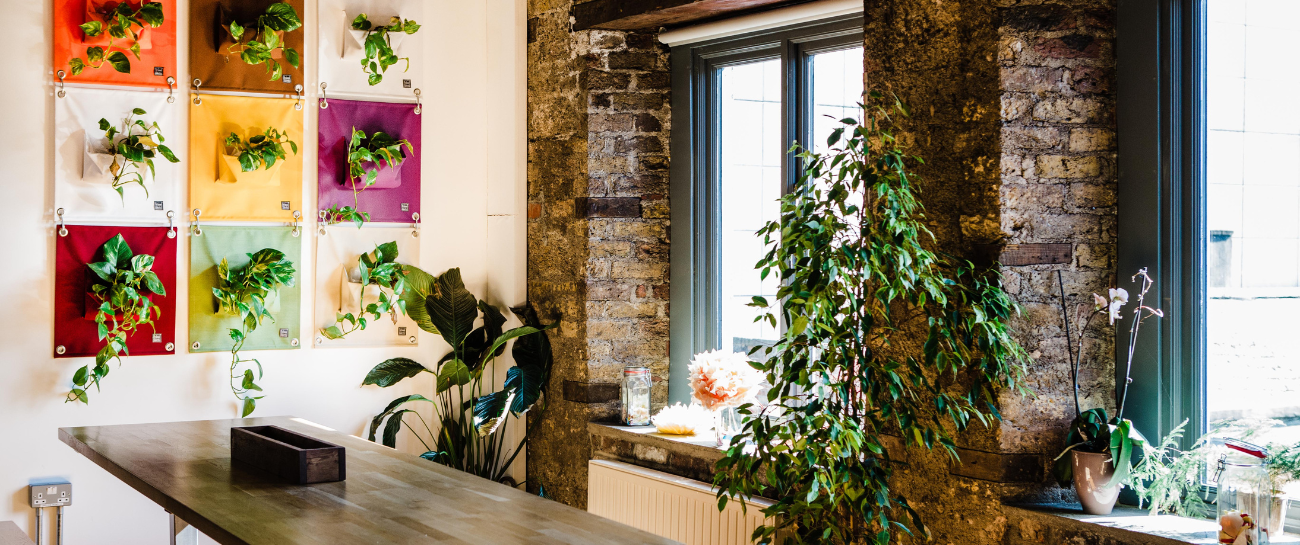The "Devil's Ivy", "Scindapsus", "Pothos", or "Epipremnum Aureus" is a very popular indoor plant, with multiple names, both botanic and common, making it difficult to identify by name alone.
By sight, it is discernible, with its obvious trailing stems and distinctive leaf markings, fully on show. This houseplant stands out thanks to its heart-shaped satiny leaves.
Devil’s Ivy is a member of the Araceae family and grows in south-east Asia, Indonesia and on the Solomon Islands. In tropical rainforests, it prefers to climb up trees and comes in many different varieties such as "Golden Pothos", "Marble Queen Pothos", "Neon Pothos", "Jade" and "Pearl Pothos".

Health Benefits of Devil's Ivy Plant
Along with its striking beauty, the Devil’s Ivy is also one of the top air-purifying plants listed in Nasa's "Clean Air Study". It helps to remove harmful and often toxic pollutants in the air such as formaldehyde and high levels of dust.
The Devil’s Ivy is named so because of its rapid rate of growth and needs a lot of carbon to produce new cells. It takes in a lot of air through its leaves, uses the carbon and stores the unwanted chemicals.
According to NASA’s study, Devil's Ivy is particularly beneficial to those who suffer from asthma or breathing problems.
Rapid cell growth and increased photosynthesis are like plugging in an air filter in your room. Having Devil's Ivy in your home will reduce airborne mould and air contaminants, which are a major trigger of allergies, asthma and other breathing problems.
This affordable plant will help to significantly improve the quality of air in your home and your breathing.

How to care for your Devil's Ivy Plant
Devil’s Ivy is probably the most low-maintenance indoor plant in Ireland and these latitudes.
It will generally adapt to any environment and can thrive in almost all conditions making it an excellent choice for plant beginners.
With this in mind, there are a few things you can do to keep your Devil’s Ivy looking its best.
![]() Sunlight: Generally the paler the leaves, the more light the plant needs. We recommend positioning your Devil’s Ivy in a bright spot but avoid direct sunlight, as this can scorch the leaves. If placed in a dimly lit area, this will likely produce more sparse vines with spaced out leaves.
Sunlight: Generally the paler the leaves, the more light the plant needs. We recommend positioning your Devil’s Ivy in a bright spot but avoid direct sunlight, as this can scorch the leaves. If placed in a dimly lit area, this will likely produce more sparse vines with spaced out leaves.
![]() Water: Devil’s Ivy appreciates high dampness but try to avoid overwatering. Aim to water routinely in the growing season and a great deal less in winter. Under-watering shouldn't be detrimental to the plant. The soil can be moderately damp, but do not have the roots standing in water if possible.
Water: Devil’s Ivy appreciates high dampness but try to avoid overwatering. Aim to water routinely in the growing season and a great deal less in winter. Under-watering shouldn't be detrimental to the plant. The soil can be moderately damp, but do not have the roots standing in water if possible.
![]() Temperature: Keep your Devil’s Ivy out of draughts and away from radiators. It is its happiest when kept at normal room temperature.
Temperature: Keep your Devil’s Ivy out of draughts and away from radiators. It is its happiest when kept at normal room temperature.
![]() Repotting: The Devil’s Ivy likes to be cramped and actually prefers to have its roots nice and tight in the pot. If the pot is too large the plant may die, or it will stop growing leaves and spend all its time just growing roots to fill up its new pot. You generally only need to consider repotting once the plant shows signs of no growth.
Repotting: The Devil’s Ivy likes to be cramped and actually prefers to have its roots nice and tight in the pot. If the pot is too large the plant may die, or it will stop growing leaves and spend all its time just growing roots to fill up its new pot. You generally only need to consider repotting once the plant shows signs of no growth.
![]() Food: No worries if you forget about fertilizing devil's ivy because it isn't a heavy feeder, and its growth probably won't skip a beat however some liquid plant food every 3-4 months is more than sufficient to maintain steady growth.
Food: No worries if you forget about fertilizing devil's ivy because it isn't a heavy feeder, and its growth probably won't skip a beat however some liquid plant food every 3-4 months is more than sufficient to maintain steady growth.
![]() Cleaning: As climbing plants, the Devil’s Ivy can accumulate dust quickly. Clean the leaves of dust by wiping them with a moist cloth or damp cotton. Support the leaves with one hand to avoid bruising or cracking them. Do not use oils or polishes to make the leaves shine; they can block pores, which can interfere with a plant's ability to breathe.
Cleaning: As climbing plants, the Devil’s Ivy can accumulate dust quickly. Clean the leaves of dust by wiping them with a moist cloth or damp cotton. Support the leaves with one hand to avoid bruising or cracking them. Do not use oils or polishes to make the leaves shine; they can block pores, which can interfere with a plant's ability to breathe.

Common Problems with the Devil's Ivy Plant
Black spots on the leaves / Yellow leaves
This is caused by overwatering. The soil should be moist for much of the time, but never let it sit in water.
Leaves have dry brown tips or are drooping
This is caused by underwatering. Keep your watering schedule consistent and only water once the top few inches of soil becomes dry.
Pale / Translucence / Scorched leaves
This is caused by too much light. Move your devil’s ivy it to a darker place or provide some shielding from long periods of direct sunlight
Help, my Devil’s Ivy is growing like crazy and I don’t know what to do with all of the vines!
To prune down a crazy pothos plant, you should either wrap the vines so they’re more manageable or cut some completely back to the soil surface.

Where to keep your Devil's Ivy Plant
While Devil’s Ivy will generally work in most rooms of the home, we see it happiest in bedrooms, living rooms, hallways and bathrooms.
The Devil’s Ivy thrives well on shelves or bookcases as they require less light and can withstand irregular watering.
They are happy to be in a hanging pot or sit on a high shelf to trail downwards, but you can also train them to climb up your wall or across a surface. We recommend using clear stick-on hooks (used for hanging picture frames) to guide your plant wherever you like. A couple of hanging specimens side by side can also help create the illusion of a green curtain or room divider.

Where to buy a Devil's Ivy Plant online in Ireland?
The good news is that no matter your size or budget, we have a Devil’s Ivy for you! We stock Devil’s Ivy in 2 size varieties on our online plant store.
If you enjoyed this blog, why not check out some of our similar posts:
- Plant Spotlight: Spider Plant
- Plant Spotlight: Monstera Deliciosa
- A guide to choosing the right plant for each room of your home
Wait! Before you go, join the plant party over on social:
@plantstoreireland





